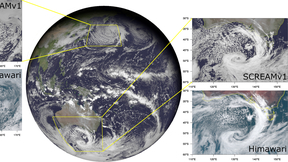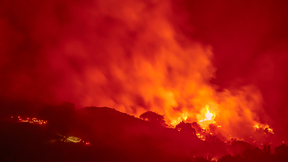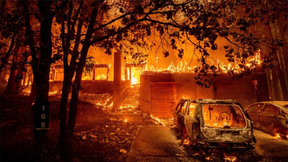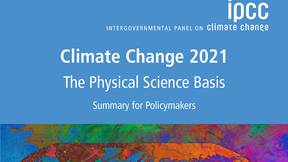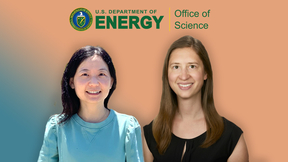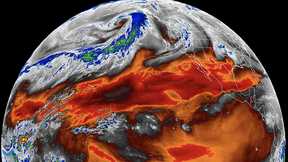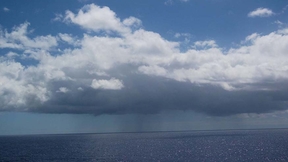Back
Climate science
A pattern of temperature change emerges from natural climate fluctuations
When comparing model simulations of Earth’s recent warming to real-world observations, differences can arise from several factors, including model errors in the simulated response to increased greenhouse gases and natural fluctuations within the climate system. Natural climate variability, also called internal variability, can change regional and global atmospheric…
Lab study on climate sensitivity earns top notch in list of influential research
The American Geophysical Union is celebrating the 50th anniversary of its journal Geophysical Research Letters (GRL) by showcasing some of the highest-achieving papers that have been published over the past 50 years. A paper by Lawrence Livermore National Laboratory (LLNL) scientists is one of the winners. The paper, “Causes of Higher Climate Sensitivity in CMIP6 Models,”…
LLNL-led SCREAM team clinches inaugural Gordon Bell Prize for climate modeling
A Lawrence Livermore National Laboratory (LLNL)-led effort that performed an unprecedented global climate model simulation on the world’s first exascale supercomputer has won the first-ever Association for Computing Machinery (ACM) Gordon Bell Prize for Climate Modelling, ACM officials announced Thursday. The Simple Cloud Resolving E3SM Atmosphere Model (SCREAM) team, led…
LLNL scientists among finalists for new Gordon Bell climate modeling award
A team from Lawrence Livermore National Laboratory (LLNL) and seven other Department of Energy (DOE) national laboratories is a finalist for the new Association for Computing Machinery (ACM) Gordon Bell Prize for Climate Modeling for running an unprecedented high-resolution global atmosphere model on the world’s first exascale supercomputer. The Gordon Bell submission, led…
Human-caused climate change at the center of recent California wildfires
Summer wildfire seasons in California routinely break records. The average summer burn area in forests in northern and central portions of the state have increased fivefold between 1996 and 2021 compared to between 1971 and 1995. Although the drivers of increased temperature and dryness are known, the contribution of human-caused climate change to wildfire activity,…
Clear human influence on atmospheric temperature changes
New research shows that it is now virtually impossible for natural causes to explain satellite-measured changes in the thermal structure of Earth’s atmosphere. The analysis conducted by Lawrence Livermore National Laboratory (LLNL) scientists and colleagues for the first time demonstrates that extending “fingerprinting” techniques — used to identify the human effects on…
New analysis helps reconcile differences between satellites and climate models
Satellite observations and computer simulations are important tools for understanding past changes in Earth’s climate and for projecting future changes. However, satellite observations consistently show less warming than climate model simulations from 1979 to the present, especially in the tropical troposphere (the lowest ~15km of Earth’s atmosphere). This difference has…
2022 Gulbenkian Prize for Humanity jointly awarded to the IPCC
The United Nations (UN) Intergovernmental Panel on Climate Change (IPCC) was jointly awarded the Gulbenkian Prize for Humanity, alongside the Intergovernmental Science-Policy Platform on Biodiversity and Ecosystem Services (IPBES). The prize jury distinguished the two intergovernmental organizations for their role in developing scientific knowledge, alerting society and…
Earth System Grid Federation launches effort to upgrade global climate data system
The Earth System Grid Federation (ESGF), an international multi-institutional initiative that gathers and distributes data for top-tier computer simulations of the Earth’s climate, is preparing a series of upgrades that will make using the data easier and faster while improving how the information is curated. A new project called ESGF2, encapsulates the primary U.S…
The Simple Cloud-Resolving E3SM Atmosphere Model (SCREAM)
Numerical models are a critical tool for predicting Earth’s future climate conditions due to the complex and inter-related processes controlling weather. While simulating the whole planet imposes severe computational challenges, global coverage is nonetheless necessary as local behavior propagates rapidly to distant areas of the globe. To solve these challenges, Peter…
Speeding up detection of climate change response to emission reductions
If humans decrease their greenhouse gas emissions to the atmosphere, how quickly would we detect a slowdown in global warming? In a recent study published in Nature Communications, Lawrence Livermore National Laboratory (LLNL) climate scientist Mark Zelinka and collaborators developed a novel approach to more quickly see the temperature response to strong emissions…
Human-caused climate change increases wildfire activity
The western United States has experienced a rapid increase of fire weather as the vapor pressure deficit (VPD) increases in the area during the warm season. New research by scientists at University of California, Los Angeles (UCLA) and Lawrence Livermore National Laboratory (LLNL) shows that two-thirds (approximately 68 percent) of the increase in VPD is due to human…
Updated exascale system for earth simulations
A new version of the Energy Exascale Earth System Model (E3SM) is two times faster than its earlier version released in 2018. Earth system models have weather-scale resolution and use advanced computers to simulate aspects of Earth’s variability and anticipate decadal changes that will critically impact the U.S. energy sector in coming years. Version 2 of the Energy…
American Meteorological Society to present Zelinka with Henry G. Houghton Award
The Council of the American Meteorological Society (AMS) has selected atmospheric scientist Mark Zelinka of Lawrence Livermore National Laboratory (LLNL) to receive the Henry G. Houghton Award. Zelinka was cited by AMS for “innovative advances in understanding the critical involvement of clouds to achieve a better understanding of climate interactions.” According to AMS,…
Climate Change Comes into Focus
Advanced computer models, simulations, and analysis capabilities help scientists zoom in on Earth system processes and improve climate research.
IPCC reports climate change is widespread, rapid and intensifying
Scientists are observing changes in the Earth’s climate in every region and across the whole climate system, according to the latest Intergovernmental Panel on Climate Change (IPCC) Report, released today. Many of the observed climate changes are unprecedented in thousands, if not hundreds of thousands of years, and some of the changes already set in motion — such as…
DOE honors Schmidt and Zheng, two early career Lab scientists
Two scientists from Lawrence Livermore National Laboratory (LLNL) are recipients of the 2021 Department of Energy’s (DOE) Office of Science Early Career Research Program award. Andrea Schmidt and Xue Zheng are among 83 scientists nationwide selected for the recognition. Under the program, typical awards for DOE national laboratory staff are $500,000 per year for five years…
Satellites may have underestimated warming in the lower atmosphere
New research by Lawrence Livermore National Laboratory (LLNL) climate scientists and collaborators shows that satellite measurements of the temperature of the troposphere (the lowest region of the atmosphere) may have underestimated global warming over the last 40 years. The research appears in the Journal of Climate. The team studied four different properties of tropical…
Observations show marine clouds amplify warming
A new analysis of satellite cloud observations finds that global warming causes low-level clouds over the oceans to decrease, leading to further warming. The work, led by researchers at Lawrence Livermore National Laboratory (LLNL), in collaboration with colleagues from Scripps Institution of Oceanography and the NASA Langley Research Center, appears online in Nature…
Improved models of cloud drizzle-turbulence interactions could enhance future climate predictions
Large decks of closely spaced stratocumulus clouds hover over the ocean and cover vast areas — literally thousands of miles of the subtropical oceans — and linger for weeks to months. These marine clouds reflect more solar radiation than the surface of the ocean, providing a cooling effect on the Earth’s surface. Stratocumulus clouds are an important component of the Earth…





